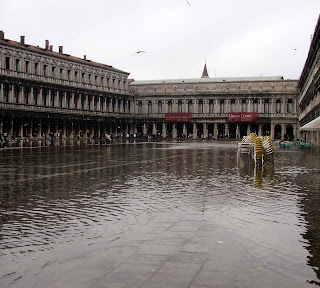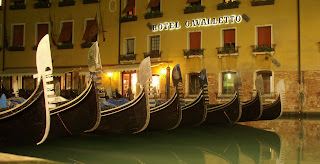If you're thinking that we went to Venice on the yacht, take a look at a map! It is a 700 mile thrash around the toe and heel of Italy, and all the way to the top of the Adriatic – about 6 days non-stop at the speed we normally travel. We took the train, which takes around 12 hours!
It was my 40th birthday treat, and an excuse to get away from our small home and stay in a real bed for the first time in 18 months. We'd sat out some uncomfortable storms in Vibo Marina and so we were pleased to be on our way to a hotel where you don't get seasick in bed, and your beer doesn't fall off the table.
We got lucky with our choice of hotel, small but cheap by Venice standards and very close to the railway station. (We stayed in Hotel Florida €75 per night per room B&B)
Weatherwise its was like entering another country – only a few degrees above zero most of the time, and of course very damp. Very much like an English winter. We spent four days in Venice wandering up and down the canals with a 3 day waterbus or vaporetti pass (for which 2 tickets costs the same as 50 minutes in a gondola), and visiting the outer island of Murano, with its streets of shops displaying tacky glass ornaments, sorry, I mean beautifully hand-crafted works of art.
Our trip co-incided with the last 2 days of the Art Biennale, a six month long contemporary art festival that takes place every 2 years here. We avoided the large exhibitions of Tracey Emin and the likes as it's not really our bag, but scattered throughout the city were small shows, which were free to enter and gave access to pavilions not normally open to the public. Our favourite was the Mexican exhibit. Rafael Lozano-Hemmer seemed to be one of the few whose exhibits reflected the theme – Think with the senses- feel with the mind. One large room was devoted to a mexican wave of chairs. As you walked around them, a computer sensed your movements and the chairs would go up and down in a rhythmical wave corresponding to your speed and direction.
In another room, large white and empty, your silhouette on the wall tunes a worldwide radio receiver, the larger your shadow the higher the volume – very cleverly done, although a bit screechy if you stood in the wrong place.
In another room you activated a projection onto the floor of film of someone sleeping. As you stood above them, they'd wake up and appear to interact with you, and if you didn't move they would go back to sleep. Sounds naff, but it was cleverly executed. Stu though that one of the girls wanted to sleep with him, it was so realistic!
 |
| Invisible sheep – yeah right |
The Ukrainian exhibition was in an absoulutely beautiful pavilion. There were some fascinating movies of a scene where nothing moves for several minutes, although a cigarette clearly burns away and drops ash on the floor in the middle of a crowded pub. Another fascinating time lapse of a dying swan draped over a naked girl. Not sure how they combined the pictures, but the swan slowly decayed, a process that must have taken several days, while the girl was motionless.
It went downhill fast upstairs in the pavilion, where the display consisted of holiday photos and sad Ukrainian prostitutes in various states of dress on nylon bedspreads in cheesy hotel rooms.
Not sure what the message of that exhibit was, but the view of the canal from the window was very good!
 |
| From the sublime to the ridiculous: |
Our trip also co-incided with the festival of Santa Maria della Salute. This fine church on the opposite bank of the Grand canal to St Marks, was built in gratitude for the end of an outbreak of plague that devastated the population of Venice in 1630-31. Every year a pontoon bridge is built across the canal from St Marks to the church just for a couple of days. On 21 November thousands of people parade across the bridge to the church to give thanks for their good health, pray for sick family or friends, and then gorge themselves candy floss and toffee apples behind the church afterwards.
 |
| Venice sports a new pontoon bridge for the day, and Santa Maria della Salute has a facelift for her birthday. |
A regular occurrence in Venice in the winter months is Acqua Alta, or high water. It depends on many factors, spring tides, rainfall, atmosperic pressure, tidal flow and winds in the Adriatic. A 1.10m predicted tide covers St Marks Square in about 60cm of water at it's worst, and many of the lower lying canalside streets are submerged. The problem is gradually getting worse as parts of Venice are built on soft sand that is slowly sinking, and the water levels are gradually rising. Duck boards are put up to keep tourist pedestrian traffic moving throughout the floods, and it is a strange sight to see tourists shuffling along the boards in single file. We were forewarned of the predicted high water, so we took our sailing boots along with us so that we could slosh through the streets like the locals.
The shops have boards to keep the worst of the water out, you just step over them to get in the shop, and under the floor they often have a bilge pump to expel the excess water back out into the street. We felt quite at home in this watery predicament and we were fascinated to see this working city attempting to go about its normal business. Considering that England can't function for wet leaves or a centimetre of snow, you have to hand it to the Venetians.
Unfortunately our trip had to end, as there is no way we could afford to spend too long in Venice.
Even the churches charge an entrance fee. Some are free, and others are accessible with a Chorus card - €8 covers the admission fee to 16 admission-charging churches. Poking our heads into these churches we couldn't really see much difference between these and the free ones.
The cost of living here is extremely high, although with care you can find the cafes and restaurants frequented by the locals, that still charge fair prices. There is no sense to this though – they are scattered throughout the city between the tourist traps, and usually don't display a menu. It seems that it is a legal requirement in Italy to display the prices of drinks somewhere in the establishment, so if you head on inside and search you will probably find out. However we found cheaper lunch venues had no menu at all. You just have to bustle in amongst the locals, ask what they have,and hope it doesn't cost too much. By comparison, the tourist venues are offering 'tourist menu €15 ' on a chalkboard outside. It is usually crap. Anything published in the Rough Guide is usually closed – they've probably made their money and ran – with very few exceptions, as we found throughout Spain and Italy.
If you are out and about in Venice, the Fondamenta della Misericordia in Cannaregio, had several good value restaurants, particularly one that appeared to be only a wine bar, with no sign of serving food. We discovered that it had a great value menu in the last few hours that we were in Venice, despite having walked past it several times day and evening.
It is a fabulous city. After four days it is strange to see a car again. All transport in Venice is by water. Goods are delivered by cart through the narrow streets. Its hard to imagine life like this. And after dark the city assumes a damp, mysterious air with a sea mist arising from the canals, that allows you to imagine just how it was several hundred years ago.
It is possible to visit Venice in our own boat, although to do a 'James Bond' you would have to take the mast down to get under the first bridge! There are places to anchor for free, and it would be really cool to spend some more time there, but it is a very long way to go to the top of the Adriatic. After questioning many people about their trip through Croatia, we have decided to give it a miss for the time being. Although it is a beautiful country, and we were happy to pay the €200 cruising permit, we were told of exceptionally rude and aggressive demands for payment in most anchorages. They welcome charter crews to their towns, to spend money in their restaurants, but are positively rude to those on a budget who choose to anchor out. Normally we don't listen to the negative comments of other cruisers, and say that we are happy to go and find out for ourselves. However there is so much to see in the Mediterranean that we really don't need to suffer treatment like that, so unless we are overwhelmed with news of recent positive experiences, we will head on past the Adriatic in spring and get to Greece and Turkey as soon as the weather allows.



















